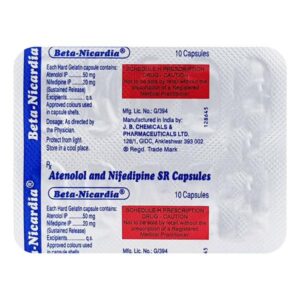ATENOLOL + NIFEDIPINE
Atenolol: Atenolol is a medication classified as a beta blocker. It is commonly prescribed for the treatment of high blood pressure (hypertension) and certain heart conditions such as angina (chest pain) and arrhythmias (irregular heart rhythms).
The mechanism of action of atenolol involves blocking the effects of adrenaline (epinephrine) on the beta receptors of the heart and blood vessels. By doing so, it reduces the heart rate, decreases the force of contraction of the heart muscle, and lowers blood pressure. These effects help to reduce the workload on the heart and improve blood flow through the arteries.
Atenolol is typically taken orally in tablet form. The recommended starting dose for hypertension is usually 50 mg once daily, but the dose can vary depending on the individual and the severity of their condition. For angina or arrhythmias, the dose may be higher, up to 100 mg once daily or divided into two smaller doses.
As with any medication, atenolol can cause side effects. Common side effects include fatigue, dizziness, cold hands or feet, and slow heartbeat. Less common but more serious side effects can include severe allergic reactions, difficulty breathing, depression, and worsening heart failure symptoms. It is important to consult with a healthcare professional for a complete list of side effects and to discuss the potential risks and benefits before starting atenolol.
Nifedipine: Nifedipine is a medication that belongs to the class of drugs known as calcium channel blockers. It is commonly prescribed to patients with angina (chest pain) and high blood pressure (hypertension). Nifedipine works by relaxing and widening the blood vessels, which helps to improve blood flow and reduce blood pressure.
For angina, Nifedipine comes in the immediate-release form and is usually taken orally as needed, with a typical dose of 10 to 20 mg. The extended-release form of Nifedipine is commonly used to treat high blood pressure. The usual starting dose for this condition is 30 mg, taken orally once a day, and the maximum recommended dose is 90 mg per day.
As with any medication, Nifedipine can cause certain side effects. The most common side effects include headache, dizziness, flushing, and swelling in the ankles or feet. Other reported side effects may include nausea, heartburn, muscle cramps, and a rapid heartbeat. Rare but serious side effects that may require immediate medical attention include chest pain, fainting, allergic reactions, and signs of liver problems such as yellowing of the skin or eyes.
It is essential to note that Nifedipine could interact with other medications or medical conditions, so it is crucial to inform your healthcare provider about all the medications you are taking, as well as any medical conditions you have, before starting Nifedipine. They will be able to assess the safety and appropriate dosage of the drug for your specific situation.

